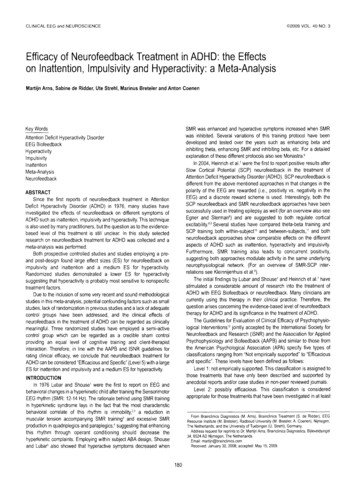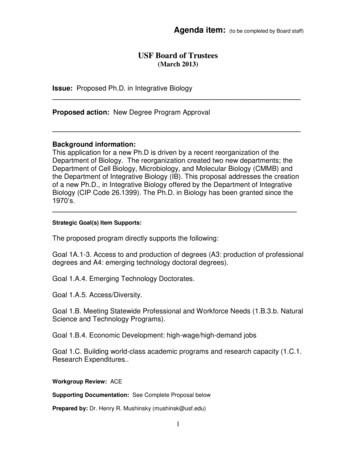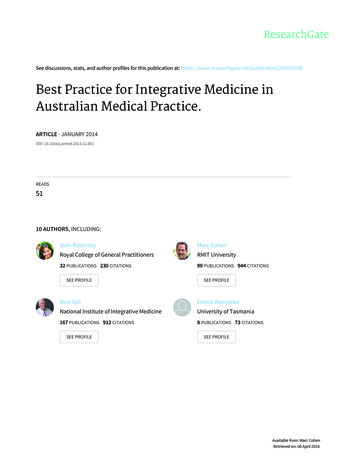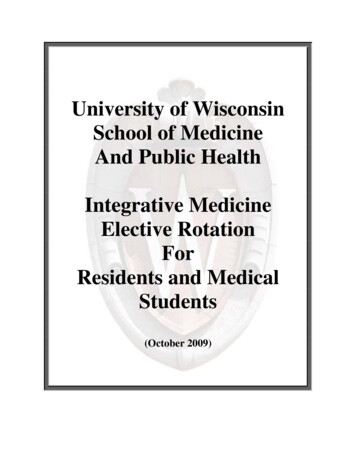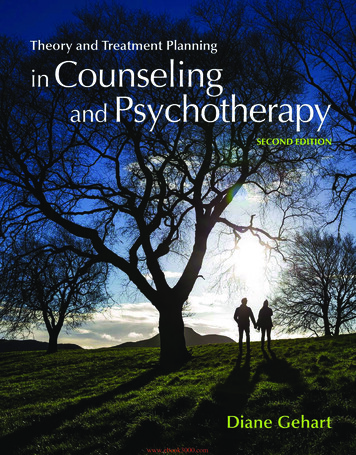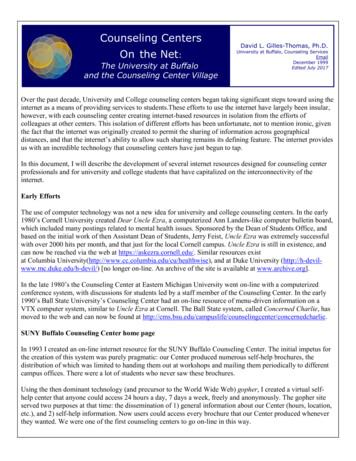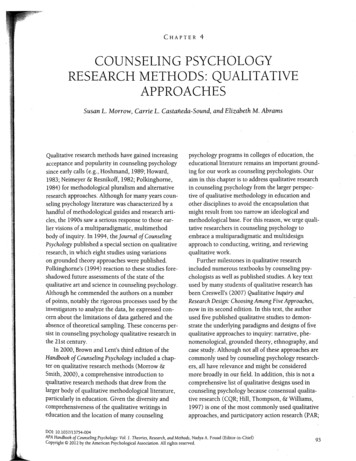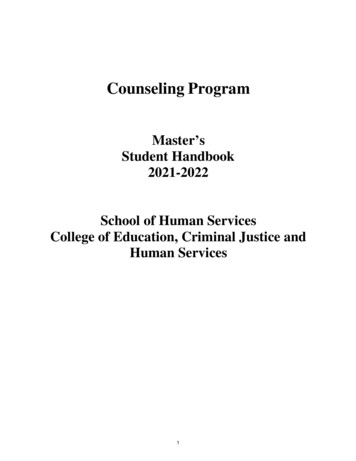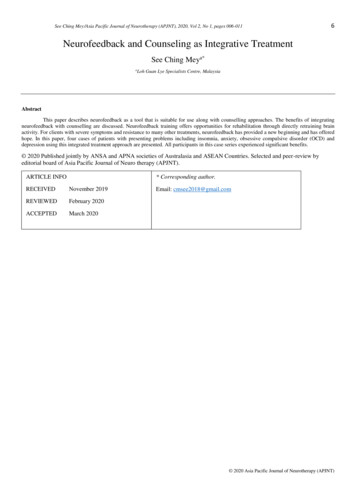
Transcription
See Ching Mey /Asia Pacific Journal of Neurotherapy (APJNT), 2020, Vol 2, No 1, pages 006-0116Neurofeedback and Counseling as Integrative TreatmentSee Ching Meya*aLoh Guan Lye Specialists Centre, MalaysiaAbstractThis paper describes neurofeedback as a tool that is suitable for use along with counselling approaches. The benefits of integratingneurofeedback with counselling are discussed. Neurofeedback training offers opportunities for rehabilitation through directly retraining brainactivity. For clients with severe symptoms and resistance to many other treatments, neurofeedback has provided a new beginning and has offeredhope. In this paper, four cases of patients with presenting problems including insomnia, anxiety, obsessive compulsive disorder (OCD) anddepression using this integrated treatment approach are presented. All participants in this case series experienced significant benefits. 2020 Published jointly by ANSA and APNA societies of Australasia and ASEAN Countries. Selected and peer-review byeditorial board of Asia Pacific Journal of Neuro therapy (APJNT).ARTICLE INFO* Corresponding author.RECEIVEDNovember 2019REVIEWEDFebruary 2020ACCEPTEDMarch 2020Email: cmsee2018@gmail.com 2020 Asia Pacific Journal of Neurotherapy (APJNT)
See Ching Mey /Asia Pacific Journal of Neurotherapy (APJNT), 2020, Vol 2, No 1, pages 006-0111.7IntroductionCounselling is often an important part of treatment in helping patients with mental disorders. It has also been shown thatcounselling can be even more effective when combined with alternative forms of treatment such as neurofeedback (Goodwin andMontgomery 2006). Neurofeedback relies on principles of neuroplasticity and enables the patient to alter his/her brain wave activitythrough training for the purpose of improving health, wellbeing and performance. Neurofeedback may be thought of as a three-stepprocess. First becoming aware of a brainwaves response, then learning to control the response, and finally transferring control ofthe response to everyday life.It is our view that Neurofeedback offers the mental health professionals a powerful complementary tool that may beintegrated with counseling to treat a variety of mental disorders. Furthermore, neurofeedback has the potential to provide researchersa unique opportunity to investigate clinical interventions with biological evidence of their efficacy.Research is highly supportive of counselling approaches which include therapeutic characteristics of listening, empathicunderstanding, building relationship of trust, gaining insight, and building on strengths and wellness. The findings also support thenotion that awareness of environment, culture and self shapes the individual. The bridge between biological and psychologicalprocesses is erasing the old distinction between mind and body, between mind and brain — the mind is the brain.It is our thesis that the integration of counselling and neurofeedback treatments will enhance the treatment process givento patients resulting in speedy recovery and improved mental health and wellbeing.2.Role of Neurofeedback In Helping People With Mental DisordersResearch shows that neurofeedback training can be helpful in cases such as anxiety (Kerson, Sherman & Kozlowski, 2009;Scheinost et al., 2013; depression (Hammond, 2013; Wang at al., 2016; Cheon, Koo & Choi, 2016); eating disorder (Bartholdy etal., 2013; Schmidt & Martin, 2016); insomnia (Hammer et al., 2011; Buckelew, Degood & Taylor, 2013; Arns et al., 2014);obsessive compulsive disorder (Sürmeli & Ertem, 2011); post traumatic stress (Gapen et al., 2016) and schizophrenia (Bolea, 2010;Sürmeli et al., 2012).A common complaint among the adult and ageing population is insomnia, generally defined as the subjective sense thatsleep is difficult to inititate or maintain, or that sleep itself is non-refreshing. Neurofeedback has been shown to positively impactsleep. With neurofeedback, most people can train their brain to improve sleep and this improvement can be surprisingly quickfor patients who have attempted many other forms of intervention and struggled with sleep for years (Cortoos, 2010; Hammer,2011).OCD is characterised by recurrent and persistent thoughts, impulses, images (obsessions) and repetitive behaviours(compulsions) or mental acts that the person is driven to in order to attempt to control the obsessions. Neurofeedback can help thebrain regulate itself better, and reduce the symptoms of brain dysregulation that occur with OCD (AboutNeurofeedback 2012).Research evidences suggests a neurophysiological basis for depression, particularly in people with a family history ofdepression (Hammond, 2013). Research indicates that the left frontal area of the brain is associated with positive emotions andapproach motivation, which is a desire to be involved with other people. The right frontal area of the brain is more associated withdepression and fear, accompanied by motivation to withdraw from and avoid other people. Neurofeedback treatments for depressionappears very promising not only in bringing relief from depression, but in modifying the underlying biological predisposition forbecoming depressed (Hammond 2013).3.Role of Counselling In Helping People With Mental DisordersThis paper focuses on four mental disorders - namely, Anxiety, Insomnia, Obsessive Compulsion Disorder (OCD) andDepression. In addition to neurotherapy a number of different counselling approaches were utilised in the treatment of subjectsincluded in this series.There are many models, approaches and techniques in counselling. Some of the most commonly used counsellingapproaches for patients with mental disorders are Cognitive Behavioural Therapy (CBT/CEBT), Behavioural Therapy,Psychoanalysis and Reality Therapy.Patients who are treated using CBT can expect their therapist to be problem-focused, and goal directed when addressingand challenging problems.Behavioural therapy focuses on human behaviour and looks to eradicate unwanted or maladaptive behaviour. Typically,this type of therapy is used for those with mental disorders that involve unwanted behaviour. Examples of this can include Anxiety,Insomnia, Obsessive Compulsion Disorder (OCD) and Depression. Practitioners of behavioural therapy believe that behaviour islearned and can therefore be un-learned via therapy. As well as the behaviour itself, the therapists will look at the thoughts andfeelings that lead to the behaviour or occur as a result of the behaviour to understand it at a deeper level (Hayes 2004). Behaviouraltherapy is an action-based therapy that looks to foster positive behaviour change (Cherney 2013).Psychoanalysis is another approach based upon the theory that our present is shaped by our past (Channel 2008). Pastexperiences that are hurtful can remain in the unconscious and subconscious mind, influencing present mood as well as behaviour.This can lead to problems with self-esteem, personality, relationships and work. Psychoanalysis helps a patient take control of theseinfluences by tracing them back to their origins and understanding how they have developed over time. This awareness offers thepatient the opportunity to deal constructively with the way these influences have affected their present life. 2020 Asia Pacific Journal of Neurotherapy (APJNT)
See Ching Mey /Asia Pacific Journal of Neurotherapy (APJNT), 2020, Vol 2, No 1, pages 006-0118Reality Theory maintains that all human behaviour is internally motivated. Behavioural choices represent the best attemptat any one moment to meet one or more of the basic needs which are built into the generic structure (Burke 2012). This theory holdsthat all human beings have the same five basic needs and they are the drivers of all human behaviour. The theory suggests that allhuman beings have the same behaviour system and that behaviour is driven by a person’s attempt to meet their basic needs. (Glasser1998). With this approach, patients are guided to make choices and control their own behaviour, not someone else's - humanbehaviour is seen as determined by what goes on inside of the person due to external forces. Reality therapy focuses on the futureby helping individuals to take ownership of and responsibility for their actions, which allow them to direct their own lives (Burke2012).4.Case PresentationFour patients with presenting problems including Insomnia, Anxiety, OCD and Depression are presented in this paper.These patients were diagnosed by the psychologist and given integrative treatment using neurofeedback and counselling. Their ageranges from 40 to 70 years old. Below is a summary of treatment and outcomes.In all cases neurofeedback protocols have been determined by clinical experience of the author and also a number of otherneurotherapists based on the principle of “what works”. While rewarding activity in the Delta range might be seen as controversialby some, we have had successful outcomes using the protocols outlined in these case studies.These protocols used are described below along with the goal that the training hopes to achieve.Neurofeedback ProtocolsCase 1: Patient diagnosed with anxietyPatient A Detail:GenderAgeDiagnosisFemale42Generalised Anxiety Disorder (GAD)Patient A was diagnosed with GAD. She had symptoms of anxiety such as constant worrying, sense of fear, restlessness,and negative thinking about events/things around her resulting in her responding emotionally over small matters. She appeared calmon the outside, but she said her brain never stopped thinking. She also had problem falling asleep, muscle tension, and shortness ofbreath. She had extensive fast brainwave activity in the right frontal lobe of the brain, which would seem to corresponded to hercomplaint of being unable to shut her mind off from her worries and thus, I also hypothesise that it is linked to her sleeping problems.The patient did not want to be put on medication so the integrative treatment was recommended. Neurofeedback aimed todecrease the level of arousal, and thus, training aimed to activate middle or low frequency brain wave activity instead of highfrequency activity (Jacobs 2013). After about 6 sessions of neurofeedback, the patient said that she was able to fall asleep easilyand slept for 6-8 hours without waking up, managed her worries and fear, and had less muscle tension.The protocols used for the patient and their associated goals were T6 Beta:Improve social behaviour; F7 – F8 Delta:Reducerunning thoughts; P4 Delta:Improve sleep; and T3 – T4 Delta: Improve calmness.The patient also underwent counselling sessions using CBT and Behaviour Therapy forthnightly for the months of Juneand July, and once a month in the months of August and September.Neurofeedback Sessions:MonthSessionTreatment ProtocolJuneSession 1 – Session 5JulySession 6 – Session 10T6 Beta, F7 – F8 Delta,P4 Delta, T3 – T4 DeltaAugustSession 11 – Session 12SeptemberSession 13 – Session 16Total sessions16*** P4 & T3 – T4 Delta treatment is alternated based on the symptoms she was displaying at the time.Findings:Presenting Problem Constant worrying Negative thinking Emotional when she was dealing with people at home and at herworkplace Running thoughts resulting in her inability to fall asleepOutcome Was able to challenge her irrational thinking Was able to manage her worries Able to manage her emotion while dealing with people Able to control outburst of emotion Can fall asleep and stay asleep for 6-8 hoursCase 2: Patient with insomniaPatient B Detail:GenderAgeDiagnosisFemale48InsomniaPatient B had difficulty falling asleep or staying asleep. She complained that she felt tired after waking up. She experiencedfatigue and could not focus or concentrate on her work. She lacked motivation and experienced mood swings. 2020 Asia Pacific Journal of Neurotherapy (APJNT)
See Ching Mey /Asia Pacific Journal of Neurotherapy (APJNT), 2020, Vol 2, No 1, pages 006-0119The patient had difficulty initiating sleep and staying asleep. There is some evidence that theta training is suitable forpatients who have difficulty initiating sleep while delta training benefits patients who have problems maintaining sleep (Diaz, Slootet al. 2012).The protocols and associated goals used for the patient was T3 – T4 Delta: Improve calmness; P4 Delta : Improve sleep;F2 Beta : Improve motivation; and F3 Beta: Improve Mood.The patient underwent counselling weekly for the month of July and forthnightly for the month of August. The psychologistused Behaviour Therapy and CBT in the counselling sessions.Neurofeedback Sessions:MonthSessionTreatment ProtocolJulySession 1 – Session 7AugustSession 8-16Total sessions16*** F2 Beta is alternated with F3 Beta starting from Session 6-16.T3 – T4 Delta, P4 Delta, F2 Beta, F3 BetaFindings:Presenting Problem Tired after waking up Fatigue all day Could not focus nor concentrate Mood disturbancesOutcome Using the techniques trained in the counselling session, she isable to fall into sleep and sleep through the night withoutwaking up Felt rested in the morning Able to focus and go about her daily activities CheerfulCase 3: Patient with Obsessive Compulsive DisorderPatient C Detail:GenderAgeDiagnosisMale72Obsessive Compulsive Disorder (OCD)Patient C held a high position in a corporate company and had always realised that he had some sypmtoms of OCD, butwas never diagnosed nor had he sought help. When he retired, he realised that his problems affected his homelife and this led tofurther stress.The patient expressed obsessive thoughts and displayed compulsive behaviour.Frontal lobe overarousal has been assosciated with repetitive thoughts, worries and urges (Jacobs 2013). Delta training at frontallobe sites aims to lower beta and hi-beta activity in order to reduce anxiety and obsessive thoughts.The treatment protocols and associated goals were F3 Beta:Reduce depression; T4 Delta: Emotional calming; and T3 – FzDelta: Reduce obsessiveness.The patient was rational and had insight. He was determined to change. He attended weekly counselling for two monthsand completed all the assignments given by the psychologist. Techniques from CBT and Reality Therapy were used.Neurofeedback Sessions:MonthSessionNovemberDec emberTotal sessionsSession 1 – Session 5Session 6 – Session 1111Treatment ProtocolF3 Beta, T4 Delta, T3 – Fz DeltaFindings:Presenting Problem Fear of contamination or dirt Having things orderly and the way he wants it to be Unwanted repetitive thoughts Aggressive or horrific thoughts about harming himself orothersOutcome Reduced fear of contamination or dirt Able to walk away if things are not orderly and as he wants it tobe Noted unwanted repetitive thoughts and able to challenge theirrational thoughts Able to pause and review aggressive or horrific thoughts aboutharming himself or othersCase 4: Patient diagnosed with depressionPatient D Detail:GenderAgeDiagnosisFemale41Depression 2020 Asia Pacific Journal of Neurotherapy (APJNT)
See Ching Mey /Asia Pacific Journal of Neurotherapy (APJNT), 2020, Vol 2, No 1, pages 006-01110Patient D was diagnosed with early on-set of depression. She was feeling low in spirit, and sometimes felt that life was nolonger worth living. She complained of persistent feelings of sadness and loss of interest. This was accompanied with feelings ofhopelessness, worthlessness, helplessness and restlessness, along with suicidal ideation and a suicide attempt.In neurofeedback therapy with patients who have depression, brain training typically focuses more on the patient's frontaland temporal lobes. Hammond (2005) concluded that neurofeedback not only moderates depression but also mitigates anxiety andrumination.During neurofeedback, the treatment protocol and associated goals were F7 – F8 Delta : Reduce running thoughts; C4Delta : Calm unconcious mind; F2 Beta : Improve motivation; F3 Beta: Reduce depression; and T3 – T4 Delta : Improve calmness.Patient D came for counselling every fortnight. Using psychoanalysis techniques, she was able to identify the events andpeople who made her sad. She explored her past experiences with the goal that understanding these experiences would help her tomanage her anger and the thoughts of ending her life.Neurofeedback Sessions:MonthSessionTreatment ProtocolAugustSeptemberOctoberSession 1 – Session 2Session 3 – Session 9Session 10 – Session 16Total sessions16F3 Beta, T4 Delta, T3 – F2 DeltaFindings:Presenting Problem Less motivated to do tasks5. Running thoughts Annoyed by past and present family issues Sad feelings with suicidal thoughtsOutcome Able to occupy herself with beneficial activities Able to control her running thoughts Resolved inner conflict and became calmer when she deltwith family members. Does not get annoyed easily No more suicidal thoughtsImplications and RecommendationsThis case series is limited to just four cases, each with very different presentations. The interventions are personalised andthus vary between cases. This represents an exploratory study of outcomes where neurofeedback is integrated with variouscounselling approaches as an intervention for different mental health disorders.Future research might focus in more detail on one particular mental health disorder and investigate different protocols fortreatment. Follow up studies should ideally include objective measures to assess outcomes and use standardised treatment protocolsand procedures.6.ConclusionsThis exploratory case series provides some support for an integrative treatment model incorporating neurofeedback alongwith psychotherapy/counseling approaches. There are many questions and issues outstanding, but this case series indicates somepromising directions for clinical interventions and for future research.ReferencesAboutNeurofeedback (2012). "Anxiety." Retrieved 10 December, 2014, from ty/.AboutNeurofeedback (2012). "Obsessive Compulsive Disorder." Retrieved 10 December,2014, from sivecompulsive-disorder/.Arns M, Feddema I, Kenemans J, L. (2014). Differential effects of theta/beta and SMR neurofeedback in ADHD on sleep onset latency. Front Hum Neurosci. 8:1019.Bartholdy, S., Musiat, P., Campbell, I, C., Schmidt, U. (2013). The potential of neurofeedback in the treatment of eating disorders: a review of the literature. EuropeanEating Disorders Review: The Journal of the Eating Disorders Association 21, 456–463.Bolea A. S. (2010). Neurofeedback treatment of chronic inpatient schizophrenia. J. Neurother. 14, 47–54 10.1080/10874200903543971Braintrain. (2014). "Neurofeedback for Other Conditions." Retrieved 10 December, 2014, from neurofeedbacksupports/.Buckelew, S., Degood, D., Taylor. J., (2013). Neuroflexibilty and sleep onset insomnia among college students: Implication for neurotherapy. Journal ofNeurotherapy.Burke, D. (2012). "Choice Theory and Reality Therapy." Retrieved 9 December, 2014, from herapy.html.Channel, B. H. (2008). "Psychoanalysis." Retrieved 14 December, 2014, from YCHOANALYTIC TREATMENCheon, E., Koo, B., & Choi, J. (2016). The efficacy of neurofeedback in patients with major depressive disorder: An open labeled prospective study. AppliedPsychophysiology And Biofeedback, 41(1), 103. doi:10.1007/s10484-015-9315-8 2020 Asia Pacific Journal of Neurotherapy (APJNT)
See Ching Mey /Asia Pacific Journal of Neurotherapy (APJNT), 2020, Vol 2, No 1, pages 006-01111Cherney, K. (2013). "Behavioral Therapy." Retrieved 10 December, 2014, from y#Overview1. Clinic, M. (2009)."Biofeedback." Retrieved 9 December, 2014, from http://www.mayoclinic.org/.Cortoos, A, et al. (2009), " An Exploratory Study on the Effects of Tele-neurofeedback and Tele-biofeedback on Objective and Subjective Sleep in Patients withPrimary Insomnia", Applied Psychophysiology and Biofeedback, Vol. 35, pp 125-134, 2010.Diaz, B. A., et al. (2012). "EEG-Biofeedback as a Tool to Modulate Arousal: Trends and Perspectives for Treatment of ADHD and Insomnia."Fagan, J. and I. L. Shepherd (1970). "Gestalt therapy now: Theory, techniques, applications."Gapen M., van der Kolk B. A., Hamlin E., Hirshberg L., Suvak M., Spinazzola J. (2016). A Pilot study of neurofeedback for chronic PTSD. Appl. Psychophysiol.Biofeedback 41, 251–261. 10.1007/s10484-015-9326-5Glasser, W. (1998). "Choice theory." New York: HarperPerennial.Goodwin, E. A. and D. D. Montgomery (2006). "A cognitive-behavioral, biofeedback-assisted relaxation treatment for panic disorder with agoraphobia." Clinicalcase studies 5(2): 112-125.Hammer, B. U., Colbert, A. P., Brown, K. A., & Ilioi, E. C. (2011). Neurofeedback for insomnia: A pilot study of Z-score SMR and individualized protocols. Appliedpsychophysiology and biofeedback, 36(4), 251-264. https://doi.org/10.1007/s10484-011-9165-yHammond, D. C. (2013). "Neurofeedback for Depression." Retrieved 10 December, 2014, from cfm.Hammond, D. C. (2005). "Neurofeedback treatment of depression and anxiety." Journal of Adult Development 12(2-3): 131-137.Hayes, S. C. (2004). "Acceptance and commitment therapy, relational frame theory, and the third wave of behavioral and cognitive therapies." Behavior therapy35(4): 639-665.Jacobs, M. S. (2013). "Psychological factors influencing chronic pain and the impact of litigation." Current Physical Medicine and Rehabilitation Reports 1(2): 135141.Kerson, C., Sherman, R. A., & Kozlowski, G. P. (2009). Alpha suppression and symmetry training for generalized anxiety symptoms. Journal of Neurotherapy, 13,146-155. doi:10.1080/10874200903107405Leanza, N. (2012). "NeuroCounseling: Simple Therapeutic Interventions for Rewiring the Maladaptive Brain." Psych Central. Retrieved 10 December, 2014, ladaptive-brain/00011117.Moore, N. (2000). "A review of EEG biofeedback treatment of anxiety disorders." Clinical EEG (electroencephalography) 31(1): 1-6.Renaud, J. J. J. M. G. (2014). "Predicting Who Benefits Most From Cognitive-Behavioral Therapy for Anxiety and Depression." Journal of Clinical Psychology70(10): 924-932.Rupke, S. J., et al. (2006). "Cognitive therapy for depression." Am Fam Physician 73(1): 83-86.Scheinost, D. et al. (2013). Orbitofrontal cortex neurofeedback produces lasting changes in contamination anxiety and resting-state connectivity. Transl. Psychiatry3, e250. doi: 10.1038/tp.2013.24Schmidt J., & Martin A. (2016). Neurofeedback against binge eating: A randomized controlled trial in a female subclinical threshold sample. Eur. Eat. Disord.Rev.24:406–416. doi: 10.1002/erv.2453.Surmeli, T., & Ertem, A. (2011). Obsessive compulsive disorder and the efficacy of qEEG-guided neurofeedback treatment: A case series. Clinical EEG andNeuroscience. 2011;42(3):195–201.Surmeli T., Ertem A., Eralp E., Kos I. H. (2012). Schizophrenia and the efficacy of qEEG-guided neurofeedback treatment: a clinical case series. Clinical EEGNeurosci. 43, 133–144 10.1177/1550059411429531Wang L., Feng Z., Yang G., Yang Y., Wang K., Dai O., et al. (2016). Depressive symptoms among children and adolescents in western China: an epidemiologicalsurvey of prevalence and correlates. Psychiatry Res. 246 267–274. 10.1016/j.psychres.2016.09.050 2020 Asia Pacific Journal of Neurotherapy (APJNT)
Neurofeedback training offers opportunities for rehabilitation through directly retraining brain . processes is erasing the old distinction between mind and body, between mind and brain — the mind is the brain. . These patients were diagnosed by the psychologist and given integrative treatment using neurofeedback and counselling. Their age

